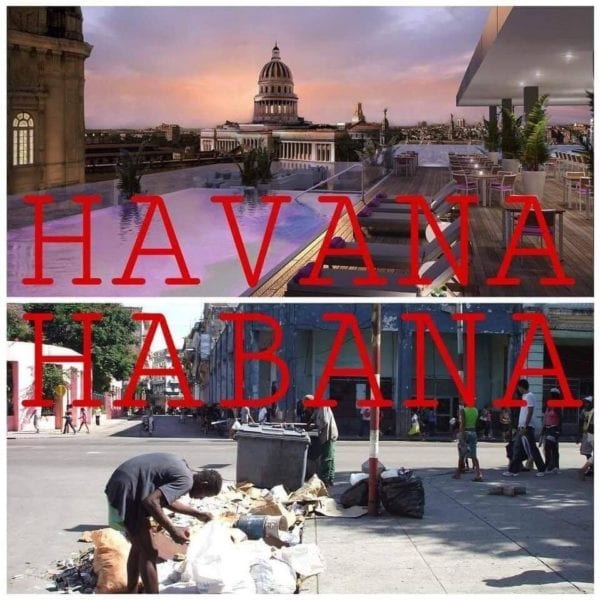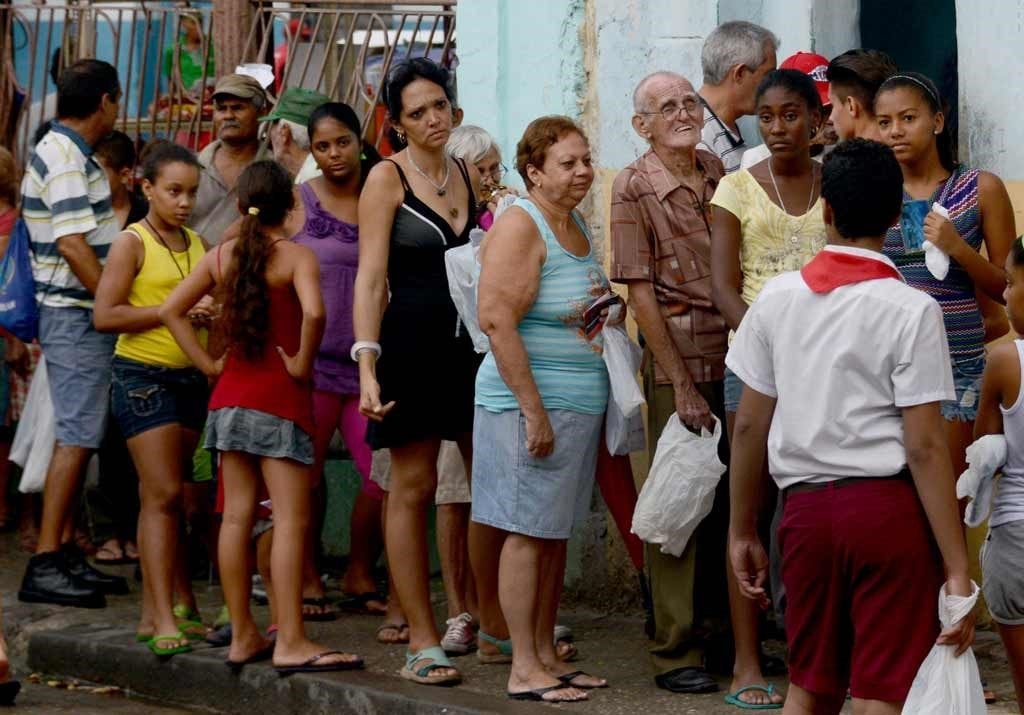Havana vs. La Habana
One City, Two Realities

By Chris Vazquez*
HAVANA TIMES – As I was scrolling through Facebook the other day, I came across the above image, and it instantly struck a chord within me. Created and shared by the Cuban American National Foundation, the picture depicts one of Havana’s five-star hotels with a view of the capitol, which stands in stark contrast to the impoverished surroundings endured by the average Havana resident just a few blocks away. Unable to keep scrolling, I felt compelled to share the photo and to impart my two cents. You see, to me the picture accurately represents the two parallel realities present throughout Cuba, most notably in the capital city of Havana. Let me explain…
We see income inequality rising around the world, and the US certainly boasts one of the staunchest gaps, with the 1% owning more wealth than the entire bottom 90%. Globally, the wealthiest 1% of the population now owns more than half of the world’s total wealth. Indeed, we’re at a point where the separation between the rich and the poor is the largest in history, and this has played a large role in the rise of populism around the globe.
But in the Cuba I love so much, is it really better for the government to artificially keep everyone “equal” at the bottom? As you might guess, I would argue it’s not.
In Cuba, the government demonizes capitalism in much the same way as US politicians have historically demonized communism. In the eyes of Raul Castro and Cuban president Miguel Diaz Canel, “un capitalista” is someone who does not conform to the country’s revolutionary ideals, and the word itself is practically a dirty insult, much like calling someone a “commie” was in the US during the Red Scare.
I am not suggesting that big business or unrestrained capitalism are the solution to Cuba’s problems, but sixty years of history has shown that a communist system and socialist policies are not getting the job done. While neither extreme is the answer, there is nothing wrong with allowing the free market to determine prices and operate efficiently in a way that serves the people.
The picture above clearly illustrates two different yet parallel cities: the “Havana” where tourists ride classic cars along the malecón and have photoshoots in flowing sundresses outside decaying pastel houses… and la “Habana,” where the residents of those decaying homes are laboring to fix their broken down classic American cars with Russian parts and fishing off the malecón for a decent meal.
As the tourists relax and the residents toil, the differences are clear as day – what the residents of la “Habana” wouldn’t give for a 2002 Toyota Camry and a plain apartment with AC and running water. The unfortunate realities of daily life for the average Cuban are so pervasive that they have made their way into the national culture and language, with phrases like en la lucha, no es fácil, and resolviendo becoming the collective motto for residents of la “Habana” working in the public sector?—?which encompasses most economic sectors outside of tourism.
This tale of two cities has been propagated in part by the dual currency system in Cuba, which has essentially created two economies: one for tourists and one for locals. Work in tourism and be paid in CUC and you’re set. Work as a skilled veterinarian after years of study and be paid in CUP and you’ll go hungry if you don’t steal or have a side hustle selling on the black market. For context, the CUP (Cuban peso) is the national currency that Cubans who work for the state are paid in. The CUC (Cuban convertible peso) is a currency that was created to address Cuba’s liquidity issues after the fall of the Soviet Union. The CUC was arbitrarily pegged to the dollar and is worth about 24 to 25 CUP’s, although both are closed currencies that do not trade on the open market – making them worthless outside of Cuba.
The problem many Cubans are faced with is not the inability to convert one currency to another, but rather the purchasing power disparity between the two currencies. As a result, one’s economic well-being is largely determined by the currency they are paid in and have access to.
The issue, therefore, is that the majority of the Cuban population is employed by the state, and their salaries are denominated in the national currency. Most consumer goods, however, are priced in the convertible currency. The result is that the average Cuban makes less than the equivalent of $25 a month but has to pay $5 just to take their spouse out for dinner at one of Havana’s lower end paladares – that’s over a quarter of their monthly salary! These restaurants are paid by and cater to tourists, so they price their meals in CUC. The equivalent cost of a $5 meal is about 125 Cuban pesos. Can you imagine dropping over a hundred dollars every time you went out for a burger?
I would argue that this form of inequality is worse than what is being experienced in the United States and elsewhere, and I wish that Cubans and tourists could stay down the hall from one another in the same hotels, eat at the same restaurants, and enjoy the island in the same ways. The hotel whose rooftop pool is depicted in the photo is the Gran Hotel Manzana, Cuba’s first 5-star resort. (no creo que sea el primer 5 estrellas)The hotel was finished in 2017, and the ground floor boasts fancy outlet shops of international brands that are reserved to tourists. It is my profound dream that the everyday Cubans walking on the street below the Manzana will one day be able to shop at those same stores alongside the international hotel guests – for now, though, they are entirely out of reach.

To solve the inequities I have outlined in the preceding paragraphs, I believe that liberal capitalism with a welfare state should be implemented in Cuba as has been done in the social democracies of the Scandinavian countries. This is entirely different from currently-trending Democratic Socialism for a slew of reasons – but that is another article for another time.
Back to liberal capitalism: What does this mean? At a high level, the way I see it is that the free market is essentially a game, and in every game, there are winners and there are losers. The market participants, or Cuban cuentapropistas, compete to increase profits and grow in size.
In a market economy, the businesses that win are those who can provide the greatest value to their consumers, whether in the form of lower prices, a better-quality product, or better service. The genius behind this method of structuring an economy is that entrepreneurs and businesses are incentivized to provide the greatest value possible to their consumers as a means of serving their own self-interests. This process of constantly striving to generate value spurs innovation and results in a “win-win-win” scenario, whereby consumers, businesses, and society as a whole all benefit together. This is the game, in a very simplified way of course.
Continuing the analogy, the role of government in this game should be that of a referee rather than that of a player, as seems to be the case in Cuba. The government should exist to protect the rights of the players and to create and enforce the rules of the game, guaranteeing a level playing field and preventing cheating or foul play.
However, as with any game, in order for there to be winners there must also be losers. Therefore, in addition to ensuring fair play, the government should also utilize its resources to create a real social safety net to protect the losers of the game, hence the welfare state.
Disloyal competition
In Cuba, however, the state competes directly against the private sector and rigs the rules in its favor by restricting businesses’ access to wholesale markets, controlling imports and exports, and implementing unjust regulations designed to prevent the accumulation of wealth and to hamper growth within the private sector.
Moreover, the Cuban government also has complete control over foreign investment, channeling the flow of foreign capital to its own, state-owned enterprises. This lack of access to capital (both foreign and domestic) puts Cuban cuentapropistas at a disadvantage to government businesses and other independent businesses who are better-connected with family and resources outside the island. The result is an imbalanced playing field that heavily favors the Cuban state and a select few independent businesses.
For this reason, the opening of the private sector in Cuba should be universal and inclusive. Among other shifts, this leveling of the playing field would entail the Cuban government re-allocating its resources away from inefficient businesses (like state restaurants and grocery stores) to matters it should be handling, such as the creation and maintenance of social services. While the Cuban government does provide a social safety net of free healthcare and education, that net is riddled with holes as the quality of both services has declined drastically over time, and neither translate to a higher quality of life in Cuba.
The fruits of the Revolution are rotten, and the Cuban people are going hungry as a result. The current state of the Cuban dystopia is such that the government understands it needs the tax revenue from the private sector to fund the inefficient and bloated public sector. They paradoxically need capitalism in order to perpetuate their socialist economy.
Consequently, the prevailing system places an emphasis on punishing the winners of the game more so than anything else. This disincentivizes innovation and progress, and it flips the game on its head by imposing a very low ceiling that crushes the human desire for growth. The result is la “Habana,” a city where Cubans live their lives hustling on the black market and where engineers drive taxis to feed their families. This underground city often goes unnoticed by visitors to “Havana,” who spend their time sipping mojitos and taking those taxis driven by doctors and engineers on sunset drives along the malecón.
—–
*Other articles by Chris Vazquez:






It is interesting that an article which describes the reality of Cuban life attracts only a couple of comments, but one on visitors from cruise ships detracting from the enjoyment by a bar hopping visitor at the Hotel Nacional ($400 per night – over a year’s income for the average Cuban), attracts almost forty.
The “Inequality in Havana” photographs encapsulate on the one hand the luxurious hotels for tourists from the prosperous capitalist world funding the communist regime, and on the other hand the squalor of the streets where Cubans have to endeavor to exist under repression.
Readers should also note the expressions on the faces of those shown lining up for the libreta, the resignation necessary to live under communism. There is no joy, the requirements for Cubans seeking to have a quiet live are simple”
“Don’t challenge the system, accept it, stay mute and exist.”
As the author wrote: “The fruits of the revolution are rotten.”
Talk about being caught between a rock and a hard place. Ref: La Havana y Havana, a tale of State imposed stratification.” Wealth is the main symbol of society stratification.”